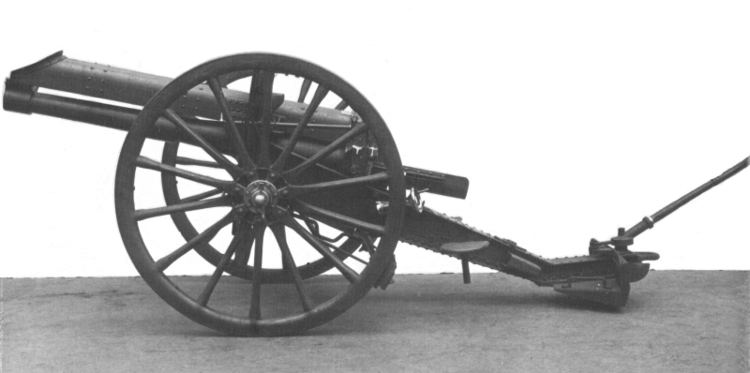Type Light field gun In service 1907 - 1918 Wars First World War | Place of origin United Kingdom Used by British Empire No. built 536 | |
 | ||
The Ordnance BLC 15 pounder gun (BLC stood for BL Converted) was a modernised version of the obsolete BL 15 pounder 7 cwt gun, incorporating a recoil and recuperator mechanism above the barrel and a modified quicker-opening breech. It was developed to provide Territorial Force artillery brigades with a reasonably modern field gun without incurring the expense of equipping them with the newer 18 pounder. It is the gun that writers usually mean by "15 pounder gun" in World War I, but can be confused with the earlier Ordnance QF 15 pounder Ehrhardt or Ordnance BL 15 pounder, both of which fired the same shell.
Contents
Design
Many modifications were made to the old BL 15 pounder barrels to adapt them to a new carriage with a recoil buffer and recuperator above the barrel similar to the modern 13 pounder design. Previously, the barrels had been mounted directly on the carriage by trunnions. Now, the barrel was suspended from a forged-steel inverted U-shaped cradle which had trunnions to attach it to the carriage. The trunnions, sight brackets and elevating gear attachment lugs were removed from the barrel. The radial T-vent hole on top was plugged, holes in the jacket passing through the trunnion centres were sealed with screwed steel plugs, and the holes in the hood for fitting tangent sights were plugged with white metal alloy.
The 3-motion breech was replaced by a single-motion interrupted screw breech, which had an axial T vent running through it into the chamber, designed to take a T friction tube.
The new firing mechanism involved a new "push" type T friction tube, which was inserted into the axial breech vent. The crosspiece of the T was positioned pointing upwards. A long layer's guard was added to the left side of the cradle projecting behind the breech. A spring-loaded firing handle was built into the layer's guard. When cocked by pulling back and then released, it sprang forward and struck a firing lever on the breech, which translated the forward motion to a downward motion and propelled a firing plunger into the T of the friction tube which in turn ignited the cordite propellant charge.
In 1915, Territorial batteries guarding the east coast of England adapted their 15 pounders for use against Zeppelins, by simply digging a pit to accommodate the trail of the gun, to allow it to be trained upwards. It is unlikely that this arrangement was ever used operationally. In a more sophisticated adaptation, two 15 pounders were modified for anti-aircraft use by increasing the allowed elevation to more than 60°. These guns were installed at Ford Wynyard in Cape Town.
Combat service
The weapon was used by British Territorial Force, New Army and Canadian infantry divisions in all theatres of World War I until replaced by the 18 pounder from 1916 onwards.
The 10th Battery of the Royal Canadian Field Artillery (RCFA), equipped with four guns, fought a notable action in the evening of 22 April 1915 north of St Julien to hold the left of the British line where the German infantry was breaking through following their gas attack on the first day of the Second Battle of Ypres. Hence, when skillfully utilised in the role that it was intended for - against troops in the open - the gun was still effective despite being obsolete. Where infantry avoided being caught in the open, the guns were of limited use due to their light shell.
After they became redundant, from late 1916 some were retained in fixed positions on the Western Front as anti-tank guns, freeing up modern guns for their usual duties.
Number 1 15 Pounder Camel Battery RGA (today's 21 (Air Assault) Battery) served with six guns with the Indian Expeditionary Force in the Aden hinterland from 1915–1918 during the South Arabia campaign, to defend the important port at Aden against any Turkish advance. In July 1915, actions were fought in initially losing and then regaining the British advanced post at Sheik Othman controlling the water supply to Aden. Sgt Curtis was awarded the Distinguished Conduct Medal for saving his gun in these actions (presumably the first, in which two guns were lost). The Camel Battery was present when the British captured Hatum in January 1918.
The gun was the standard field artillery for the early South African Union Defence Force and saw action with the Cape Field Artillery at the Battle of Kakamas and Battle of Upington during the South-West Africa Campaign.
